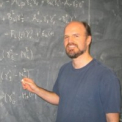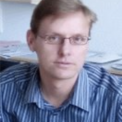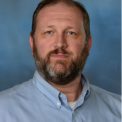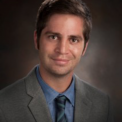In this talk, I'll first give an introduction to quantum machine learning and how one can trade quantum entanglement for data resources to get an experimental reduction in data resource requirements for quantum machine learning. I'll present a brief tutorial to give an idea of how quantum machine learning works and why this sort of tradeoff is possible. Then, I'll go on to show how quantum machine learning can be used to improve quantum simulation on near-term quantum computers showing some of our most recent results. Here, again, I'll focus on describing the structure of the problem to give the audience an appreciation of how the techniques work.
Events: Departmental Colloquia
-
Quantum Machine Learning and Quantum Simulation
-
What is Active Matter?
Describing and predicting real-world phenomena is an important task for physics. Not only in the microscopic world, but also in the macroscopic world there are still many non-trivial phenomena waiting to be challenged by physical sciences. Active matter is a population of self-propelled particles that convert free energy into motion or force. Examples include flocks of birds, populations of biological cells, cell cytoskeleton, self-driven colloidal particles and vibrated granular rods. Collections of those active particles exhibit solid, liquid and gas like behavior and beyond. A number of deep analogies exist between equilibrium statistical physics systems and active matter systems including phase transitions and macroscopic dynamics. In active matter systems, on the other hand, new macroscopic properties arise. The ordered state of a certain class of cell population closely resembles the order of liquid crystal molecules, but novel phenomena such as spontaneous condensation of cell population into topological defects. may explain the mechanism of morphogenesis in living organisms.
-
Understanding optomechanical coupling and nonlinear phononics effects in materials
Controlling optomechanical effects, i.e. the coupling of atomic degrees of freedom with light, is of fundamental importance for quantum sensing, quantum transduction, and quantum machine learning applications. Of particular interest to applications is the stabilization under laser irradiation of states of matter otherwise unstable in thermodynamics equilibrium. In this talk, I will present our recent theoretical progress in understanding the atomic-scale, non-thermal response of materials to visible light. Using first-principles methods as an approximation to the time-dependent Schrödinger equation, I will show how light can result in non-thermal excitations of the atomic lattice in simple materials like III-V semiconductors, and how simple classical models of this response based on generalized Langevin equation can capture the light-induced dynamics. I will then show how non-thermal effects become prominent in more complex, broken-symmetry materials such as Charge Density Wave (CDW) materials. Using the CDW state of the layered transition-metal dichalcogenide, Tantalum Disulfide (1T−TaS2) as a case study, I will show how light can couple with structural order parameter in CDW materials, leading to optomechanical coupling coefficients two orders of magnitude larger than the ones of diamond and ErFeO3, an effect confirmed experimentally. Our findings suggest nonlinear phononics processes in CDW materials can be deterministically controlled to engineer states of matter with large non-linear optical susceptibility.
-
The stochastic thermodynamics of computation
One of the major resource requirements of computers — ranging from biological cells to human brains to digital computers — are the free energy costs in running them. These thermodynamic properties of computers have been a long-standing focus of research in statistical physics, going back (at least) to the early semi-formal work of Maxwell and of Szilard.
Recent revolutionary breakthroughs in stochastic thermodynamics are allowing us for the first time to analyze the thermodynamics of computers in a fully rigorous manner. Here I illustrate some of these recent results, including the thermodynamic costs of (loop-free) digital circuits, of Turing machines, and of asynchronous distributed computers like the interacting organelles in a cell.
-
Investigations of Carbon and Oxygen in Young Stellar Objects and Implications for the Early Solar System
In this talk, I will describe my ongoing results of high-resolution astronomical observations of young stellar objects (YSOs) across the Galaxy, and their unique windows into protoplanetary and pre-biotic chemistry. As analogues of the solar nebula, YSOs that are rich in CO isotopologues (12C16O, 13C16O, 12C18O, 12C17O) enable both the study of early exoplanetary systems as well as important comparisons with isotopic measurements in carbonaceous chondrites – the most primitive meteorites and relics of the early solar system. I will present our recent investigations of protoplanetary carbon and oxygen using the iSHELL spectrograph at NASA’s Infrared Telescope Facility on Maunakea, where we obtain near-infrared high-resolution (R ~ 80,000-90,000) data of CO in rovibration (2- and 4-microns) toward a range of YSO environments. Our results have so far revealed heterogeneity in 12CO/13CO in YSOs in our local solar neighborhood, signatures of CO self-shielding in some YSOs, and evidence that binary protostars (the most common configuration) may not follow identical chemical evolutionary pathways. I will also discuss how our recent experiments on interstellar ice analogues at the Jet Propulsion Laboratory help interpret the YSO data. Finally, I will introduce some new projects aimed at communicating research and mission data to the public as part of my role as a research scientist and curator at a large natural sciences museum.
-
Entanglement area law in superfluid helium
Area laws were first discovered by Bekenstein and Hawking, who found that the entropy of a black hole grows proportional to its surface area, and not its volume. Entropy area laws have since become a fundamental part of modern physics, from the holographic principle in quantum gravity to ground state wavefunctions of quantum matter, where entanglement entropy is generically found to obey area law scaling. As no experiments are currently capable of directly probing the entanglement area law in naturally occurring many-body systems, evidence of its existence is based on studies of simplified theories. Using new exact microscopic ground state Monte Carlo simulations of superfluid helium, we demonstrate for the first time area law scaling of entanglement entropy in a real quantum liquid in three dimensions. We validate the fundamental principles underlying its physical origin, and explore an "entanglement equation of state" showing how it depends on the density of the superfluid.
-
Nanophotonics for enhanced sensing and spectroscopy: towards point-of-care devices
Nanotechnology and specifically nanophotonics have been at the forefront of biosensor development because they promise the integration of bulky analytical equipment into ultrasmall footprints. This size reduction makes nanophotonic approaches ideal for transitioning traditional sensing and spectroscopy concepts towards the point-of-care, enabling the delivery of rapid diagnostic results, and contributing to improved patient outcomes. In my talk, I will introduce several examples of such nanophotonics-based sensors and highlight how they can provide conceptual advances and improved performance for biomedical detection, covering a wide range of applications from lipid membrane and vesicular processes to the identification of antibodies and biomarkers for disease.
-
The New Wave of Quantum Magnetism
Magnetism is a fascinating phenomenon with roots in the ancient world. Although its precise understanding calls for relativistic quantum mechanics and field theory, it is integral to everyday technologies. In magnetic insulators, electrons are closely bound to a crystal lattice and carry strongly interacting magnetic dipoles; as a result, phases of matter with no classical analogs are possible. Such quantum magnetic phases are of great fundamental interest as a testbed of our understanding of many-particle quantum mechanics. In the first part of this lecture, I will discuss some of the central ideas in quantum magnetism, from the Heisenberg model to the more recent concepts introduced by Kitaev and others. Then, I will explain our research program to search for these simple models in bulk materials and understand their properties using neutron spectroscopy.
-
Work Function Tuning in Ferric Chloride Intercalated Few-layer Epitaxial Graphene
Ferric chloride (FeCl3) is a p-type dopant for few-layer graphene. We studied the electronic density of states of FeCl3intercalated between single-layer (stage 1) and tri-layer (stage 3) graphene with applied electric bias. The work function of these layers as a function of the electric bias was analyzed using ultraviolet photoemission spectroscopy. The results showed that the work function of graphene could be tuned in FeCl3 intercalated few-layer graphene by up to 2.5 eV by the action of the resulting electric field. Further, we compared the density of states obtained by ultraviolet photoemission spectroscopy with that calculated using density functional theory. The inherently high 6.2 eV work function of the intercalated graphene due to charge transfer from FeCl3to graphene appears to be compensated with increasing negative bias. The wide range of control over the work function of graphene demonstrated here suggests that these systems are excellent for electronic and optoelectronic applications.
-
A Dual-Stage Photonic Integrated Circuit Spectrometer
Spectrometers are key laboratory tools for many applications, from molecular identification and quantification to laser diagnostics. Addressing these applications in field-deployable scenarios requires significant size, weight, and power (SWaP) reduction from typical bulk-optic techniques. Photonic integrated circuits (PICs) are an attractive alternative to bulk-optic spectrometers because they are extremely low SWaP, are readily mass- produced, and can be ruggedized for field deployment. However, typical PIC-based spectrometers are unable to simultaneously deliver the resolution and bandwidth required for key applications such as Raman spectroscopy. Within the molecular “fingerprinting” region using a 780-nm pump wavelength, a Raman spectrometer must respond between 810–890 nm with sub-nanometer resolution. To address this application, I will present a photonic integrated circuit spectrometer that cascades an arrayed-waveguide grating with a series of coupled- resonator optical waveguide filters to achieve a spectral resolution of 0.35 nm over a bandwidth from 805–930 nm. Our team’s cascaded dual-stage spectrometer design permits simultaneous wide bandwidth and high resolution performance in a package that represents multiple orders of magnitude reduction in SWaP compared to free-space spectrometers. In this talk, I will discuss the simulation, design, and testing of our integrated circuit spectrometer as well as potential applications of our team’s technology.
-
Emerging properties of disordered plasmonic metamaterials
Ordered plasmonic structures have been utilized for a wider range of applications. However, their properties suffer from defects, when large-scale applications are desired. There is growing evidence that the exceptional properties can be produced and tuned in disordered packings with built-in heterogeneities. For example, self-assembled, tightly packed spherical clusters of nanobeads (plasmonic metamolecules) have been shown to produce strong magnetic dipole resonances, with strong local hotspots that can be used for applications such as surface enhanced Raman scattering. I discuss how one can dynamic ally control these properties by using temperature-responsive hydrogel cores, and producing clusters with mixed particle sizes and materials. The robust synthesis of these structures affords large variations in their structure and properties. I will detail how variations in these parameters can affect the magnetic response of these dynamic metamolecules (DMMs). In large enough clusters, with large nanobeads, high-order magnetic multipole modes, i.e. magnetic quadrupole, octupole, and hexadecapole resonances, are observed in simulations as well as far-field extinction experiments [1]. In another example, anisotropic plasmonic nanoparticles and two-dimensional inorganic materials can be embedded in polymer matrices to produce disordered metamaterials. The properties of these materials can be studied using linear optical methods and readily modeled using metamaterial optical modeling. This combination of experiments and modeling provides a facile in-situ technique to study self-assembly, orientation ordering, and other phase changes such as degradation in polymer nanocomposites.
-
Random Language Model
Many complex generative systems use languages to create structured objects. We consider a model of random languages, defined by weighted context-free grammars. As the distribution of grammar weights broadens, a transition is found from a random phase, in which sentences are indistinguishable from noise, to an organized phase in which nontrivial information is carried. This marks the emergence of deep structure in the language, and can be understood by a competition between energy and entropy.
Note: no background in linguistics will be assumed.
-
Gravitational Instabilities in Protoplanetary Discs: A Vanishing Act
In their youth, protoplanetary discs are expected to be massive and self-gravitating, which results in non-axisymmetric spiral structures. However recent observations of young protoplanetary discs with ALMA have revealed that discs with large-scale spiral structure are rarely observed in the midplane. Instead, axisymmetric discs with some also having ring & gap structures are more commonly observed. In the first part of the talk I will present our results of planet-disc interactions in gravitationally unstable (GI) discs. In the second half I will show our recent results of warped GI discs. Consideration of complex processes such as these has important implications on observations of protoplanetary as it shows how evolution of GI discs can be altered, potentially resolving the discrepancy between theory and observations.
-
Connecting Hydrodynamic Simulations of Planet Formation with Observations
Planets born in circumstellar disks create various disk substructures, such as gaps, rings, spirals, vortices. Similar structures are observed widely with ALMA, SPHERE and similar instruments. At least some of these disk features are likely due to forming planets, however there are also other mechanisms to explain them.
Carrying out high resolution, 3D hydrodynamic simulations with radiative transfer already included, allow us to create realistic “mock observations” or “synthetic images” for a given instrument & telescope combination. These mock observations can be compared with already existing real data, or prepare for future observational proposals. We use them to understand how massive forming planets could be observed with the different instruments, how the planet- disk interactions look like on various wavelengths and what planet-generated features we can observe with the current & near-future instrumentation. I review our findings for near- and mid- infrared, sub-millimeter and radio wavelengths, and identify what are the best wavelengths and instruments for hunting for forming planets.
-
A New Approach to the Cosmic Lithium Problem
The predictions of light element abundances in standard Big Bang Nucleosynthesis agree very well with astrophysical probes of primordial material, with the exception of lithium. Most of the observational constraints we have on the primordial abundance and cosmic evolution of Li comes by way of the Li abundance in stellar atmospheres, which are four times lower than BBN predictions in the Planck era. A broad range of potential solutions to this "lithium problem" have been suggested, from stellar astrophysics solutions (depletion of the surface Li abundances in stars) to physics beyond the Standard Model (annihilating or decaying dark matter in the epoch of BBN). We have adopted a new approach to this problem, using observations of Li in interstellar gas of low-metallicity galaxies to probe the cosmic evolution of Li. I will summarize our results using this approach, including new estimates of the 7Li/6Li ratio that show no evidence for non-standard model approaches.
-
Unipolar quantum optolectronics
Highly sensitive and ultrafast optoelectronic systems operating in the atmospheric thermal window (8–14μm) are required for free-space communications, light detection and ranging (Lidar) and for high resolution spectroscopy and in observational astronomy.
Unipolar quantum optoelectronics is a field of research of quantum physics that encompass an ensemble of semi-conductor devices aiming to develop enabling systems for applications in the atmospheric thermal window (8–14μm). The new generation of these devices is embedded into metamaterials for increasing their performances. They operate at room temperature with bandwidths of tens of GHz, ideal for free-space communications, light detection and ranging (Lidar), high resolution spectroscopy and observational astronomy.
-
Visualizing bending of RNA structures by a bound protein using Contrast Variation Small-Angle X-ray Scattering (CV-SAXS)
RNA molecules play vital roles in cellular functions, not only as facilitators of the transcription of the genetic code carried by DNA but also as non-coding molecules that promote post-transcriptional regulation of gene expression, among other functions. It is necessary to develop biophysical methods that allow visualization of the structural dynamics of non-coding RNA molecules as part of large processing complexes involving protein partners. Here, we describe how to utilize small angle x-ray scattering (SAXS) with absolute calibration and contrast variation (CV-SAXS) to detect conformational changes of a primary microRNA upon binding with a part of the microprocessor complex. This method reports only on the RNA conformation within the complex and suggests that the protein bends the RNA. Supporting work using single molecule Fluorescence Energy Resonance Transfer (FRET) to study the conformation of RNA duplexes bound to the protein also shows bending. Together, these studies elucidate the role of the protein DGCR8 in interacting with RNA during the early stages of microRNA processing. This talk will also give a broad introduction into CV-SAXS and its different applications in the study of structural dynamics of protein-nucleic acid complexes.
-
A perspective on petahertz (nano)electronics
Ultrafast electronic dynamics of solid-state materials, particularly under light excitation, are of great interests both fundamentally and practically due to the wide applications of optoelectronic devices, such as transistors, photovoltaics, or photodetectors. With the ability to control electronic dynamics in solids on attosecond time scales, the development of lightwave electronics holds promise for realizing ultrafast signal processing devices at frequencies up to the petahertz regime, surpassing current technology by orders of magnitude.
The development of light-driven petahertz electronics is inherently connected to solid state nanophysics. First, the natural length scale of electron motion on the few attosecond time scale is on the order of one nanometer. Second, for the development of petahertz integrated circuits, the devices have to be both on nanometer length scales and be based on non-resistive processes, such as ballistic electron transport. Nanomaterials or nanostructured solids thus play a crucial role in the development of future on-chip petahertz electronics devices.
The talk will give a broader introduction into this field and summarize a few recent results from our group. A perspective will be given on the next steps towards the implementation of petahertz signal processing.
-
Time-resolved optical microscopies of nanomaterials
Time-resolved optical spectroscopic techniques provide direct insight into the excited state dynamics and energies of materials. Implemented in a microscopy platform, these techniques can be utilized to establish spatio-temporal maps and to visualize photo-induced phenomena. In this talk, I will discuss three different implementations developed to address particular sample properties. First, we use time-resolved photoluminescence (PL) microscopy to visualize charge carrier diffusion in hybrid halide thin films. We implemented a scheme in which the detection point is scanned with respect to the excitation point. Pulsed laser excitation in combination with time-resolved detection then allows for the observation of charrier transport within the film. In the second example, we implemented both transient absorption and time-resolved PL microscopy to study the ultrafast dynamics of excitons in single semiconducting carbon nanotubes. This allowed us to formulate a unified model by combining unimolecular exciton decay and ultrafast exciton-exciton annihilation on a time-scale reaching down to 200 fs. In the third implementation, we explore the non-linear response of plasmonic nanoantennas using phase-shaping of broadband laser pulses. We find that the enhancement provided by resonant nanoantennas can be predicted from a complex frequency dependent field enhancement factor. We then demonstrate that the spectral phase associated with this factor can be utilized for phase-selective confocal imaging.
-
Planets, moons, and rings from the James Webb Space Telescope during Guaranteed Time Observations
Now that Webb has launched, successfully deployed, and reached its destination at L2, we can outline the plans for the James Webb Space Telescope (JWST) guaranteed time observations (GTO). Heidi Hammel’s cycle 1 GTO programs focused on Solar System science include detailed time-resolved compositional mapping of the Martian surface, short- and medium-term climate monitoring of the giant planets, and exploratory spectroscopic studies of the full menagerie of asteroids and comets, from near-Earth objects to the Kuiper belt. These programs are designed to be benchmark observations for the JWST mission. In this talk I will introduce JWST, its capabilities for the Solar System and some of the science it will accomplish during its first year of operation. The focus will be on planetary systems with Ice Giant atmospheres as a detailed example. As a queer, Black woman I will also share some of the Equity, Diversity and Inclusion work I have done over my career.
-
Near-field microscopy for nanoscale materials characterization
Semiconducting nanostructures have been proposed as material platforms for a wide variety of photonic, electronic, and photovoltaic elements. In order to realize these applications, careful design and characterization of electronic properties such as dopant concentration, activation, and distribution are needed. I will discuss the use of near-field optical microscopy as a non-destructive method for chemical, structural, and electronic imaging in nanomaterials, focusing on a specific application, the study of axially-doped silicon nanowires (SiNWs). We can detect local changes in the electrically-active doping concentration from the free-carrier absorption in both n- type and p-type doped SiNWs. The < 20 nm spatial resolution allows us to directly measure dopant transition abruptness and charge carrier properties in the vicinity of interfaces in single and multi-junction SiNWs, both in the infrared and the microwave spectral regimes. However, the tip is perturbative in terms of both the electromagnetic wave (frequency-resolved) and electrostatic (charge carrier redistribution) interactions, and this affects the measured results, an important consideration in nanostructured materials especially. Our results demonstrate the utility of near-field spectroscopy in probing local properties of nanomaterials, but emphasize the little-understood convolutional role of the tip in many forms of scanning probe microscopy.
-
Joint Theoretical and Experimental Efforts to Create New Atomic Data for Astrophysics
Almost everything we know about the Universe has been discovered through the light that reaches us from the stars, galaxies, nebulae, and other astrophysical objects. The use of spectroscopy to analyze this light has yielded information about size, temperature, composition and dynamics of a wide array of astrophysical objects from comets to planetary nebulae. No field of science places higher demands on the quantity and accuracy of atomic data than astrophysics. This data is produced by Herculean efforts of both theorists and experimentalist, but both are often needed to overcome the shortcomings of the other. This talk will discuss the aspects of some new, collaborative, joint theoretical and experimental projects to produce new atomic data that is improved for analysis and modeling of data from the increasing observational capacity of our most advanced ground- and space-based telescopes.
-
Self-Organization of Lifelike Behaviors
-
Effect of Processing on the Electrical Properties and Microstructure of Multiwalled Carbon Nanotube Films and Polymer Composites
Multiwalled carbon nanotubes (MWNT) with dimensions of 8-15 nm and 0.5-2 μm long were used to make a series of CNT films via vacuum filtration, spin coating and inkjet printing. The method of deposition as well as the substrate used (filter paper of different sizes, photopaper, glass) were found to have an influence on the arrangement of the nanotubes and their resultant electrical response. Using a combination of impedance spectroscopy, equivalent circuit modeling, and microscopy techniques, it was possible to describe in detail how the electrical properties change as a function of how the MWNTs are distributed on the porous substrates by varying the number of deposited layers (1-20) as well as the dispersion concentration (0.1 to 5 mg/mL) using the vacuum filtration method. In the in-plane, four different electrical responses were observed and modeled: (1) a substrate dominated spectrum representing unconnected MWNTs, (2) one that included bundle and junction responses as well as some inductances representing sparsely distributed MWNT networks, (3) followed by a parallel RL circuit for partially connected MWNT networks and (4) finally a series RL circuit for fully connected MWNT networks. In the thru-plane, only two different electrical responses were observed and modeled. The results for the in- plane and thru-plane properties were used to generate percolation curves that show that electrical conductivity can change as much as 10 orders of magnitude for the same exact MWNTs. Similar experiments were also carried out for films that were spin coated and inkjet printed. The specific nanotube arrangements and electrical response depend on the number of layers deposited but in principle the trends observed are the same given that we used the SAME starting nanotube materials. Our results indicate that not only do the characteristics of the nanotubes themselves play a role but also the structure of the underlying substrate and the details of how the films are deposited.
-
Overview of Tritium Fuel Cycle Research at Savannah River National Laboratory
Recent developments, along with significant private investment, has spurred increased interest in fusion as a carbon-free source of energy. Hydrogen isotopes are the most promising fuel for a fusion reactor, but the development of the associated fuel cycle presents unique challenges and opportunities. Tritium, in particular, produces additional complexity due to its scarcity and radioactivity. In this talk, I provide an overview of recent and ongoing tritium fuel cycle research at SRNL in support of fusion energy. In addition, the recent management transition at SRNL includes strategic partnerships with regional universities in Georgia and South Carolina, including the University of Georgia. Therefore, I will also provide a brief overview of SRNL, opportunities for student internships, and highlight areas of potential collaboration.
Zoom link: https://zoom.us/j/98442775233?pwd=WVc3aHl6UmxSUVlTZDNVdStDRWxzQT09
Page 1 of 11, showing 25 records out of 274 total, starting on record 1, ending on 25


























